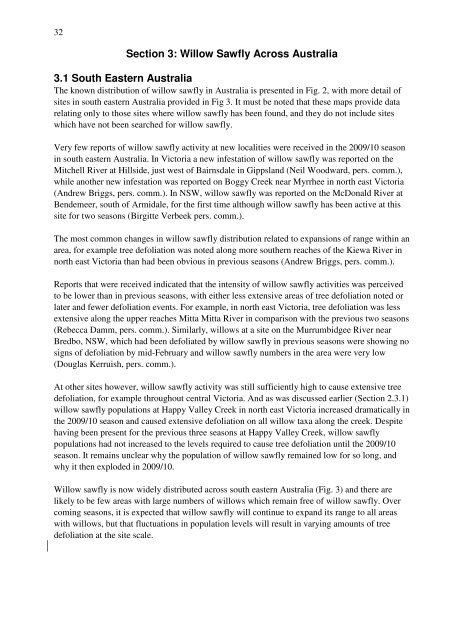Willow Sawfly Management Trials - Weeds Australia
Willow Sawfly Management Trials - Weeds Australia
Willow Sawfly Management Trials - Weeds Australia
You also want an ePaper? Increase the reach of your titles
YUMPU automatically turns print PDFs into web optimized ePapers that Google loves.
32Section 3: <strong>Willow</strong> <strong>Sawfly</strong> Across <strong>Australia</strong>3.1 South Eastern <strong>Australia</strong>The known distribution of willow sawfly in <strong>Australia</strong> is presented in Fig. 2, with more detail ofsites in south eastern <strong>Australia</strong> provided in Fig 3. It must be noted that these maps provide datarelating only to those sites where willow sawfly has been found, and they do not include siteswhich have not been searched for willow sawfly.Very few reports of willow sawfly activity at new localities were received in the 2009/10 seasonin south eastern <strong>Australia</strong>. In Victoria a new infestation of willow sawfly was reported on theMitchell River at Hillside, just west of Bairnsdale in Gippsland (Neil Woodward, pers. comm.),while another new infestation was reported on Boggy Creek near Myrrhee in north east Victoria(Andrew Briggs, pers. comm.). In NSW, willow sawfly was reported on the McDonald River atBendemeer, south of Armidale, for the first time although willow sawfly has been active at thissite for two seasons (Birgitte Verbeek pers. comm.).The most common changes in willow sawfly distribution related to expansions of range within anarea, for example tree defoliation was noted along more southern reaches of the Kiewa River innorth east Victoria than had been obvious in previous seasons (Andrew Briggs, pers. comm.).Reports that were received indicated that the intensity of willow sawfly activities was perceivedto be lower than in previous seasons, with either less extensive areas of tree defoliation noted orlater and fewer defoliation events. For example, in north east Victoria, tree defoliation was lessextensive along the upper reaches Mitta Mitta River in comparison with the previous two seasons(Rebecca Damm, pers. comm.). Similarly, willows at a site on the Murrumbidgee River nearBredbo, NSW, which had been defoliated by willow sawfly in previous seasons were showing nosigns of defoliation by mid-February and willow sawfly numbers in the area were very low(Douglas Kerruish, pers. comm.).At other sites however, willow sawfly activity was still sufficiently high to cause extensive treedefoliation, for example throughout central Victoria. And as was discussed earlier (Section 2.3.1)willow sawfly populations at Happy Valley Creek in north east Victoria increased dramatically inthe 2009/10 season and caused extensive defoliation on all willow taxa along the creek. Despitehaving been present for the previous three seasons at Happy Valley Creek, willow sawflypopulations had not increased to the levels required to cause tree defoliation until the 2009/10season. It remains unclear why the population of willow sawfly remained low for so long, andwhy it then exploded in 2009/10.<strong>Willow</strong> sawfly is now widely distributed across south eastern <strong>Australia</strong> (Fig. 3) and there arelikely to be few areas with large numbers of willows which remain free of willow sawfly. Overcoming seasons, it is expected that willow sawfly will continue to expand its range to all areaswith willows, but that fluctuations in population levels will result in varying amounts of treedefoliation at the site scale.
















